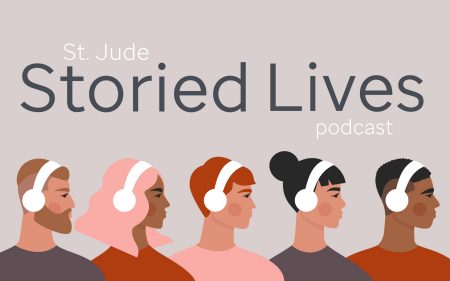
“The Invincible Summer”: How Yike Found Light in Her Darkest Days
Through cancer, Yike discovered her strength—and her summer self. Her art tells a story of survival, transformation, and the power of hope.

July 15, 2025 • 4 min

The day she turned 18 felt surreal for Yike.

She hadn’t been sure she’d reach her 18th birthday.
She hadn’t expected she’d be in Memphis, 8,000 miles from her hometown, standing on the campus of St. Jude Children’s Research Hospital® proudly displaying two of her paintings in an art show.
She certainly hadn’t expected professional basketball players from the San Antonio Spurs, who had been visiting the research hospital campus that day, to sing “Happy Birthday” to her.
Looking at her painting “Rebirth,” a self-portrait with a tree of life growing within her body, Yike said her time at St. Jude has defied expectations in so many ways.
“Without St. Jude, the tree of life might have died, but with St. Jude it is flourishing again.” – Yike
“After all the treatment I had in St. Jude, I felt like it was a rebirth of me,” Yike said. “Without St. Jude, the tree of life might have died, but with St. Jude it is flourishing again.”

Yike grew up in Guangzhou, a large port city on the Pearl River roughly 75 miles from Hong Kong. She speaks fondly of the city known for its bustling commerce and vibrant marketplaces but also leisurely dim sum meals of delicate shrimp dumplings and yolky egg buns. She grew up with her mother, father and paternal grandparents.
Her mother, Ru, encouraged Yike to pursue diverse interests hoping to coax her shy daughter out of her shell. And it worked. Yike spent active afternoons with friends, playing badminton and basketball and running track. Yike was studious, a voracious reader, with a particular interest in science and biology, and drew portraits and landscapes when she felt pensive.
“My mother inspired the curiosity I have of the world,” Yike said. “She gave me a lot of confidence, a sense of belonging, a sense of security and love.”
It was a heady and fulfilling life, which is why the fatigue that suddenly overtook Yike when she was 16 was so unexpected. So unwelcome.
Used to running every afternoon with her friends, Yike was barely able to climb stairs without gasping for breath. She wanted to nap. She found bruises all over her body. Her gums began bleeding.
Watching documentaries about cancer one day, Yike began to suspect she might be suffering from something serious and asked her mother to schedule a doctor’s appointment.
Blood tests at the doctor revealed leukemia. And a bone marrow biopsy the following day confirmed it was acute myeloid leukemia (AML), a cancer of the blood and bone marrow.
AML affects stem cells, which eventually mature into red blood cells, white blood cells or platelets. In AML, the bone marrow makes white blood cells that don’t work as they should, leaving the patient without enough healthy white blood cells to fight infections. It is the second most common childhood leukemia. Pediatric AML is most common in infants and toddlers under age 2 and in teenagers.
The rapid development and unpredictability of AML, which has several different subtypes, makes it complicated to treat. Still, despite its prevalence, the overall survival rate for AML in children has been about 70% in the U.S.

Yike began chemotherapy treatment in her hometown hospital, but her family was relocating around this time to Tennessee. Following their move, the family sought further treatment at St. Jude Children’s Research Hospital.
Yike and Ru first visited St. Jude in April 2024, just as the dogwoods were in bloom, and both mother and daughter were heartened to see a glistening skyline in downtown Memphis along the Mississippi River, a comforting similarity to the hometown they’d just left behind.
At St. Jude, doctors performed a bone marrow aspirate to see if Yike had evidence of residual leukemia following her treatment in China.
Following test results that her bone marrow was positive for AML, Yike began another round of chemotherapy at St. Jude during which she did not achieve remission, which led doctors to determine a stem cell transplant was the best option for long-term survival for Yike because the type of AML she had was high-risk and could relapse. The goal of the stem cell transplant is to replace the diseased bone marrow with healthy stem cells so the body will be able to produce healthy blood cells.
Yike received the transplant on August 2, but the process is a significant one because of energy expended from the patients body to heal from the conditioning regiment of chemotherapy and to build a new blood system.
“I was very grateful to be here. It’s a place that I can’t imagine its existence in the world.” – Yike
“I was very grateful to be here. It’s a place that I can’t imagine its existence in the world,” Yike said. “The people here, everybody is so nice, they treat you like family, made us feel like home.”
She turned to art during treatment, before and after her transplant.
She’s painted many pieces, but proudly described one she most recently finished, called “The Invincible Summer.” It is a self-portrait depicting herself as two seasons, winter and summer. It’s a duality she had experienced as a cancer patient, a winter self, sad and hollow, and a joyful, hopeful summer self.

“We all have times of difficulty, a winter in life, but the summer is invincible,” Yike said. “That’s what I feel of myself.”
“Art is like an indispensable part of my life,” she said. “I always found art as a way to express myself and especially at St. Jude. Art is another language for me to remember all the things that happened in this journey. I also see art as a way to pass down my energy to other people. I send my artwork to my friends here and also to friends back home and I hope that they will gain strength when they see my artwork.”
Since the transplant, Yike is growing stronger and her cancer is in remission. Her immune system is still recovering, but her health is improving and she plans to finish high school.
She hopes to study psychology in college, saying the therapy and counseling she received at St. Jude inspired her career path because it helped her find healthy ways to cope.
“St. Jude lightened our burden,” Yike said.








